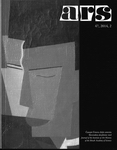
Journal ARS 47 (2014) 2
Timo HUUSKO
The Reception of Cubism in Finland
(Summary)
Cubism was an interesting interphase in Finnish art world in 1910’s and early 1920’s, even though there are not many examples of exactly cubist paintings in Finnish art history. Cubism and its reception in Finland can be traced back to the developments and history of cubism in France. Cubism was for the first time mentioned in Finnish art criticism in 1911 and the first Cubist exhibition in Finland is consider to be Uno Alanco’s exhibition in Helsinki and Kalle Kuutola’s exhibition in Vyborg at October 1913. Both of them were pupils of Henri Le Fauconnier, and Du Cubisme by Albert Gleizes and Jean Metzinger was known in Finland since 1912. Norwegian art critic Jens Thiis was the most influential messenger of new art in Finland at the time. He kept three fully-booked lessons in University of Helsinki in October 1913. His idols were Cézanne and Picasso. In his third lesson, called “From Neoimpressionism to Cubism – Object and Art” and he emphasized the bridge between Cézanne and Cubism. According to him the depicted object was thrown behind in the process that had happened from postimpressionism to abstract cubism and art itself had become the object of depiction. Thiis confessed, however, that he was not sure if the total abandonment of nature was wise enough, despite the fact that Picasso had done that. In Finland it became widely expressed opinion that cubism and especially Picasso’s cubism was logical end in a path towards abstraction, but also a dead end, which could lead nowhere. In 1914 there was a Der Blaue Reiter exhibition of “Expressionist and Cubist Art” in Helsinki, which was organized by Der Sturm gallery. Reception of that exhibition rejected cubism to nothing but compositional schemes without spiritual content. Only artist in Finland who took Cubism in Sturm context seriously, was Edwin Lydén, but it did not happen before 1920, and his art was neglected in Helsinki. Idea of expressionism as a visionary art took a strong foothold from 1915 on, even though there was an exhibition of French Cubism in Helsinki in 1915 and exhibition of Russian art, including cubism, in Helsinki year 1916. In that connection cubism was divided to jewish cubism, orphism and formal cubism by Finnish art critic Heikki Tandefelt. For Finnish art critics and for the Finnish audience expressionism represented emotions and cubism rationality, but it was not seen as an essential part of art. Those who followed art, confessed, though, that the bright colours in paintings gave way to grey and brown earthly colours, and understood that it happened partly due to cubism. The difference between Cézanne and cubism was not clearly made, and in fact it was often about combining cubist colour tones to Cézanne-like brushstrokes and modulation. This was especially the case with the Finnish November group, which held its first exhibition at the end of 1916. Tyko Sallinen was the leading figure of the group. This structural expressionism became a dominant modus for young artists, and in a way it was an example of kind of “meta-style” or syncretic style, where no one single tendency dominated. It is interesting that this “Cézanne-fever” came not only from France, but also from Norway. Actually it took till the end of 1910’s when cubism as a named style was appreciated again, now as a structural element which paves way towards classicist art ideals. Finnish writer Aaro Hellaakoski emphasized this, and took André Derain as a role model for Finnish artists. He was also supported by Onni Okkonen who became the leading art authority in Finland in 1920’s. In Finland it was natural to see the connections between cubism and classicism, because both were seen as constructive methods, which had the potential of bringing clarity and harmony to the art work.